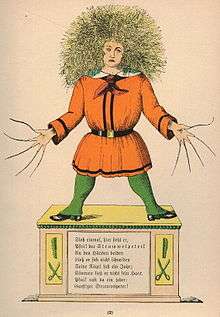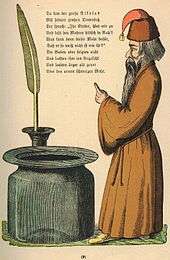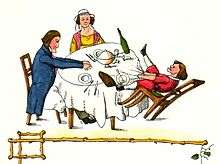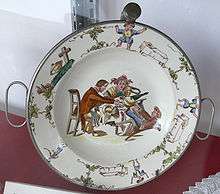Struwwelpeter

Der Struwwelpeter (1845) (or Shockheaded Peter) is a German children's book by Heinrich Hoffmann. It comprises ten illustrated and rhymed stories, mostly about children. Each has a clear moral that demonstrates the disastrous consequences of misbehavior in an exaggerated way. The title of the first story provides the title of the whole book.
Background and publication history
Hoffmann wrote Struwwelpeter in reaction to the lack of good children's books. Intending to buy a picture book as a Christmas present for his three-year-old son, Hoffmann instead wrote and illustrated his own book.[1] In 1845 he was persuaded by friends to publish the book anonymously as Lustige Geschichten und drollige Bilder mit 15 schön kolorierten Tafeln für Kinder von 3–6 Jahren (Funny Stories and Whimsical Pictures with 15 Beautifully Coloured Panels for Children Aged 3 to 6). For third edition, published in 1858, the title changed to Struwwelpeter, the name of the character in the first story. The book became popular among children throughout Europe, and, writes author and researcher Penni Cotton, the pictures and characters showed a great deal of originality and directness.[1]
Struwwelpeter has been translated into several languages. In 1891, Mark Twain wrote his own translation of the book but because of copyright issues, Twain's "Slovenly Peter" was not published until 25 years after his death in 1935.[2]
Stories

- "Struwwelpeter" describes a boy who does not groom himself properly and is consequently unpopular.
- In "Die Geschichte vom bösen Friederich" (The Story of Bad Frederick), a violent boy terrorizes animals and people. Eventually he is bitten by a dog, who goes on to eat the boy's sausage while he is bedridden.
- In "Die gar traurige Geschichte mit dem Feuerzeug" (The Dreadful Story of the Matches), a girl plays with matches and burns to death.
- In "Die Geschichte von den schwarzen Buben" (The Story of the Black Boys), Saint Nicholas catches three boys teasing a dark-skinned boy. To teach them a lesson, he dips the three boys in black ink.
- "Die Geschichte von dem wilden Jäger" (The Story of the Wild Huntsman) is the only story not primarily focused on children. In it, a hare steals a hunter's musket and eyeglasses and begins to hunt the hunter. In the ensuing chaos, the hare's child is burned by hot coffee and the hunter falls into a well.
- In "Die Geschichte vom Daumenlutscher" (The Story of the Thumb-Sucker), a mother warns her son not to suck his thumbs. However, when she goes out of the house he resumes his thumb sucking, until a roving tailor appears and cuts off his thumbs with giant scissors.
- "Die Geschichte vom Suppen-Kaspar" (The Story of the Soup-Kaspar) begins as Augustus, a healthy, strong boy, proclaims that he will no longer eat his soup. Over the next five days he wastes away and dies.
- In "Die Geschichte vom Zappel-Philipp" (The Story of the Fidgety Philip), a boy who won't sit still at dinner accidentally knocks all of the food onto the floor, to his parents' great displeasure.
- "Die Geschichte von Hans Guck-in-die-Luft" (The Story of Johnny Head-in-Air) concerns a boy who habitually fails to watch where he's walking. One day he walks into a river; he is soon rescued, but his writing-book drifts away.
- In "Die Geschichte vom fliegenden Robert" (The Story of the Flying Robert), a boy goes outside during a storm. The wind catches his umbrella and lifts him high into the air. The story ends with the boy sailing into the distance.

Music, film and stage adaptations
In 1955, a live action film based on the book was directed by Fritz Genschow. In this adaptation there is a "happy" ending where the characters' bad deeds are reversed.
Shockheaded Peter (1998) is a musical that combines elements of pantomime and puppetry with musical versions of the poems with the songs generally following the text.[3]
Little Suck-a-Thumb (1992), is a psychosexual interpretation of the infamous cautionary tale from Heinrich Hoffman's storybook. The short film by writer/director David Kaplan stars Cork Hubbert (The Ballad of the Sad Café), Evelyn Solann, and Jim Hilbert as the Great Tall Scissorman.[4]
You Suck (2008), is a short film made with shadow puppets by writer/director Richard Mansfield. The film had two sequels which featured more characters from the Struwwelpeter You only Suck twice (2009)and Mother Sucker (2010). All three films have been combined into anthology film Sucking Hell (2015)
Hilf Mir is a song by Rammstein released on 2005, and it was based on "Die gar traurige Geschichte mit dem Feuerzeug".
Media influences


W. H. Auden refers to the Scissor-Man in his 1930's poem "The Witnesses" (also known as "The Two"):
And now with sudden swift emergence
Come the women in dark glasses, the humpbacked surgeons
And the Scissor Man.
Adolf Hitler was parodied as a Struwwelpeter caricature in 1941 in a book called Struwwelhitler, published in Britain under the pseudonym Dr. Schrecklichkeit (Dr. Horrors).
The "Story of Soup-Kaspar" is parodied in Astrid Lindgren's Pippi Longstocking (1945), with a tall story about a Chinese boy named Peter who refuses to eat a swallow's nest served to him by his father, and dies of starvation five months later.
In a 1991 edition of the Thames Television detective series Van der Valk, entitled Doctor Hoffman's Children, the detective, played by Barry Foster solves a series of murders after finding the book in the bedroom of his house, when his wife relates the tale of the scissorman to their granddaughter. The murders were all done in the style of events in the book.[5]
Brief references are made to the book in the film, Woman in Gold (2015), when the central character reminisces about her youth in Vienna during the Anschluss.
The Office (U.S. TV series) references the book in Season 2, Episode 18: "Take Your Daughter to Work Day" (2006). Dwight Shrute reads "the Story of the Thumb-Sucker" to the children, but is interrupted by a horrified Michael Scott.[6]
Comic book writer Grant Morrison references "Die Geschichte vom Daumenlutscher" in the first story arc of his Doom Patrol run with the recurring line, "The door flew open, in he ran / The great, long, red-legged scissorman."
The Jasper Fforde fantasy/mystery novel The Fourth Bear opens with a police Sting operation by the Nursery Crime Division to arrest the Scissorman.
Agatha Christie references Struwwelpeter in her novel, Curtain. The story's narrator, Arthur Hastings, describes another character, Stephen Norton... "He had a habit of running his hands through his short grey hair until it stuck up on end like Struwwelpeter."
References
- 1 2 Cotton, Penni (2000). Picture Books Sans Frontières. Trentham Books. p. 11. ISBN 1-85856-183-3.
- ↑ Ashton (1995). "Fetching the jingle along: Mark Twain's Slovenly Peter" (PDF). Children's Literature Association Quarterly. Retrieved 2011-12-23.
- ↑ Elyse Sommer (2005). "Shockheaded Peter Makes a Comeback". CurtainUp. Retrieved 2009-02-19.
- ↑ "Little Suck-a-Thumb: A cautionary tale". Malaprop Productions. 2009. Retrieved 2009-05-14.
- ↑ https://www.youtube.com/watch?v=85enGz_V8uA Van Der Valk 1991, season 4 episode 1, Doctor Hoffmans Children, where the book is used to solve the murders.
- ↑ Take Your Daughter to Work Day (The Office)
Further reading
- Ashton, Susanna M.; Petersen, Amy Jean (Spring 1995). "'Fetching the Jingle Along' – Mark Twain's Slovenly Peter". The Children's Literature Association Quarterly 20 (1): 36–41.
- Carpenter, Humphrey, and Mari Prichard. (1984). The Oxford Companion to Children's Literature. New York: Oxford University Press. ISBN 0-19-211582-0
External links
| Wikimedia Commons has media related to Struwwelpeter. |
- The English Struwwelpeter, or, Pretty stories and funny pictures, Internet Archive (Ebook and Texts Archive), including downloadable versions.
- Struwwelpeter: Merry Tales and Funny Pictures at Project Gutenberg
- Der Struwwelpeter, German original on wikisource (illustrated).
- Struwwelpeter-Museum in Frankfurt, Germany (German)
-
 Struwwelpeter public domain audiobook at LibriVox
Struwwelpeter public domain audiobook at LibriVox
|